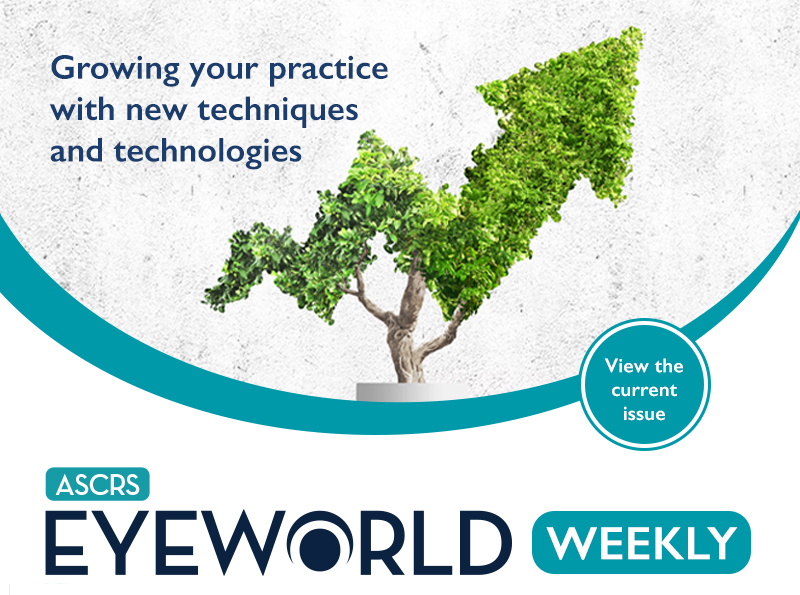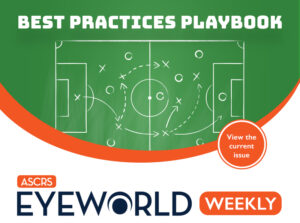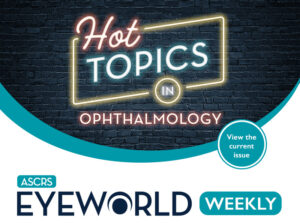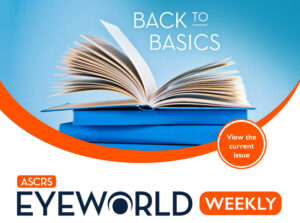FDA approves first standalone MIGS device
The FDA granted 510(k) clearance to the iStent infinite Trabecular Micro-Bypass System (Glaukos) as a standalone procedure for patients with primary open angle glaucoma (POAG) whose IOP remains uncontrolled despite prior medical and surgical therapy. According to the company’s press release, this is the first implantable MIGS device approved as a standalone procedure. Most MIGS devices are currently approved with concomitant cataract surgery. According to Glaukos, the iStent infinite includes three heparin-coated titanium stents that are preloaded into an injector system that allows the surgeon to place the stents in up to 6 clock hours of Schlemm’s canal. The company reported that the iStent infinite is similar to the iStent inject W Trabecular Micro-Bypass System, which is indicated for mild to moderate POAG with concomitant cataract surgery. The commercial launch of the iStent infinite will take place later this year.
Phase 3 clinical study results for inflammation, pain management nanosuspension
Formosa Pharmaceuticals and AimMax Therapeutics announced topline results from its Phase 3 clinical study of APP13007, a nanosuspension of clobetasol propionate for the treatment of inflammation and pain after cataract surgery. The randomized, double-masked trial that took place in the U.S. compared APP13007 to placebo in 370 participants following cataract surgery. The drop was used twice daily for 14 days, achieving its primary endpoints of sustained clearance of ocular inflammation and pain with statistical superiority over placebo. According to the company, 57.8% of participants had an anterior chamber cell count of 0 on postop day 15 with APP13007 treatment compared to 18.8% on placebo. In terms of ocular pain, 85.4% who received APP13007 were pain free as early as postop day 4 compared to 51.4% on placebo. The drug was well tolerated with a similar safety profile to placebo, the company reported.
Phase 2a clinical trial begins for investigational MGD treatment
Tarsus Pharmaceuticals has begun a Phase 2a clinical trial to evaluate TP-03 (lotilaner ophthalmic solution) for treatment of meibomian gland disease (MGD) in patients with Demodex. According to the company’s press release announcing the first patient’s enrollment, there is currently no FDA-approved pharmacological treatment for MGD. Two prior clinical trials for TP-03 have already been conducted with more than 800 patients with Demodex blepharitis, meeting primary and secondary endpoints. Tarsus plans to submit an NDA to the FDA for TP-03 for Demodex blepharitis in the second half of 2022.
Registry created to collect data on canaloplasty
Nova Eye Medical has established a new registry to collect prospective, multicenter, longitudinal data for canaloplasty as a treatment for glaucoma. According to the company’s press release, the iTrack Global Data Registry will collect real-world clinical data on canaloplasty. Specialists involved with the registry stated in a press release that this endeavor will collect uniform data across the glaucoma spectrum that could help inform decision making for surgical planning.
ASCRS news and events
- ASCRS Summer Meeting: Register for the ASCRS Summer Meeting to get a “Taste of ASCRS”—its focused, anterior segment CME and in-person experience—August 19–21, in Nashville, Tennessee.
- ASCRS Annual Meeting: The call for abstract submissions for the 2023 ASCRS Annual Meeting is open now through October 14.
- Ophthalmology Quicksand Chronicles: Episode 3 of this popular ASCRS podcast hosted by Nicole Fram, MD, and Elizabeth Yeu, MD, is now online.
Research highlights
- Toric IOLs vs. femtosecond laser-assisted arcuate keratotomy during phaco cataract surgery for correction of moderate astigmatism was evaluated in a prospective, randomized, comparison study. The research, published in the Journal of Cataract & Refractive Surgery, included 75 eyes from 67 patients with 1.25 to 3 D of corneal astigmatism. Patients were randomized to receive either a toric IOL or arcuate keratotomies created with a femtosecond laser. Mean residual refractive astigmatism at 3 months was −0.63±0.55 D in the toric group and −0.90±0.53 D in the femtosecond laser group; it was ≤1.00 D in 32 eyes (84%) in the toric group and 25 eyes (64%) in the femtosecond laser group. The authors concluded that the group receiving toric IOLs had better results in astigmatic correction, but they wrote that femtosecond laser-assisted arcuate keratotomies are safe for astigmatism reduction.
- A retrospective, clinical cohort study sought to evaluate the risk, prevalence, and progression of glaucoma in patients with AMD receiving intravitreal anti-VEGF injections compared to controls. The analysis evaluated data from 2004–2013, including eyes with exudative AMD receiving anti-VEGF treatment, and non-exudative AMD and no AMD serving as controls. There were 707 eyes of 504 patients that received anti-VEGF injections and 1,008 controls. According to the authors, there was no difference in glaucoma or glaucoma suspect at initial presentation and no difference in cumulative 5-year probability of new glaucoma diagnosis between the groups. The authors also found no difference in qualitative progression of glaucoma in eyes receiving injections compared to those with non-exudative AMD, but it was greater when to compared to eyes with no AMD. The eyes receiving injections required more topical glaucoma treatments compared to controls. Incisional glaucoma surgery was not more frequent in the eyes that required injections compared to controls. This research is published in the American Journal of Ophthalmology.
Product news
- U.S. patent protection was extended into 2039 for Nyxol (phentolamine mesylate, Ocuphire Pharma) for reversal of mydriasis.
This issue of EyeWorld Weekly was edited by Stacy Jablonski and Liz Hillman.
EyeWorld Weekly (ISSN 1089-0319), a digital publication of the American Society of Cataract and Refractive Surgery (ASCRS), is published every Friday, distributed by email, and posted live on Friday.
Medical Editors: Sumit “Sam” Garg, MD, Chief Medical Editor; Rosa Braga-Mele, MD, Cataract Editor; Clara Chan, MD, Cornea Editor; Nathan Radcliffe, MD, Glaucoma Editor; and Vance Thompson, MD, Refractive Editor
For sponsorship opportunities or membership information, contact: ASCRS • 12587 Fair Lakes Circle • Suite 348 • Fairfax, VA 22033 • Phone: 703-591-2220 • Fax: 703-591-0614 • Email: ascrs@ascrs.org
Mention of products or services in EyeWorld Weekly does not constitute an endorsement by ASCRS.
Click here to view our Legal Notice.
Copyright 2022, EyeWorld News Service, a division of ASCRSMedia. All rights reserved.




